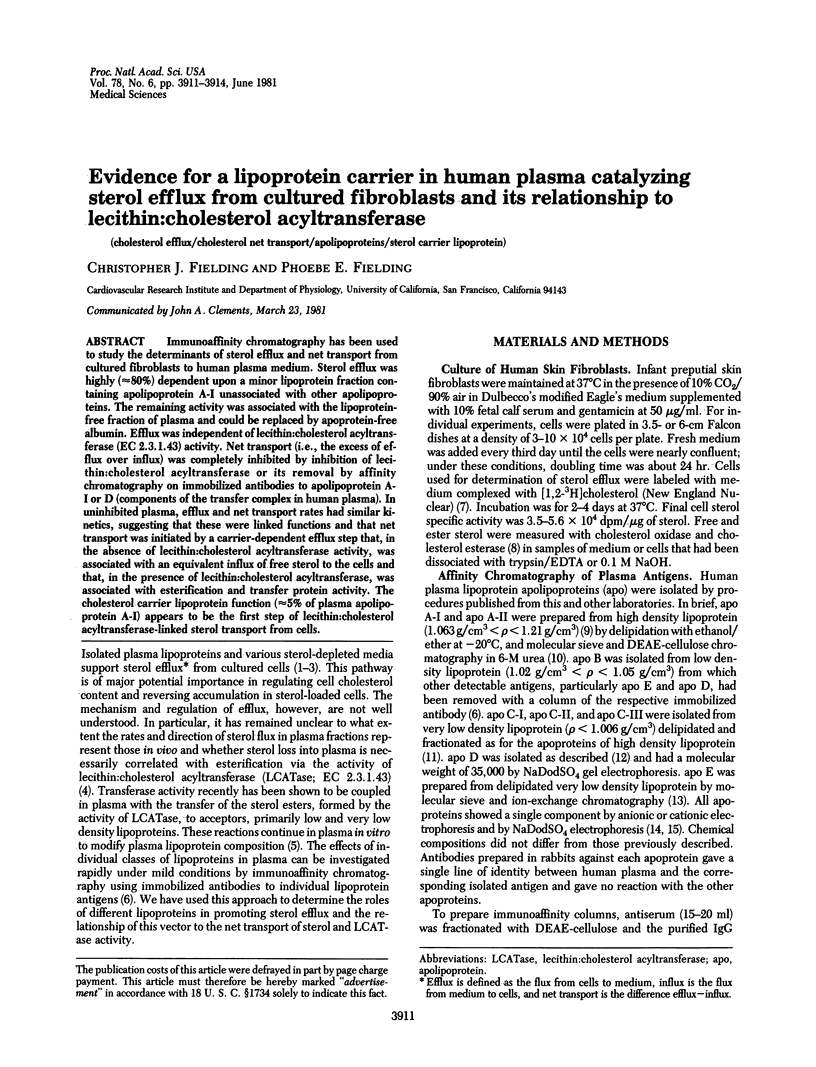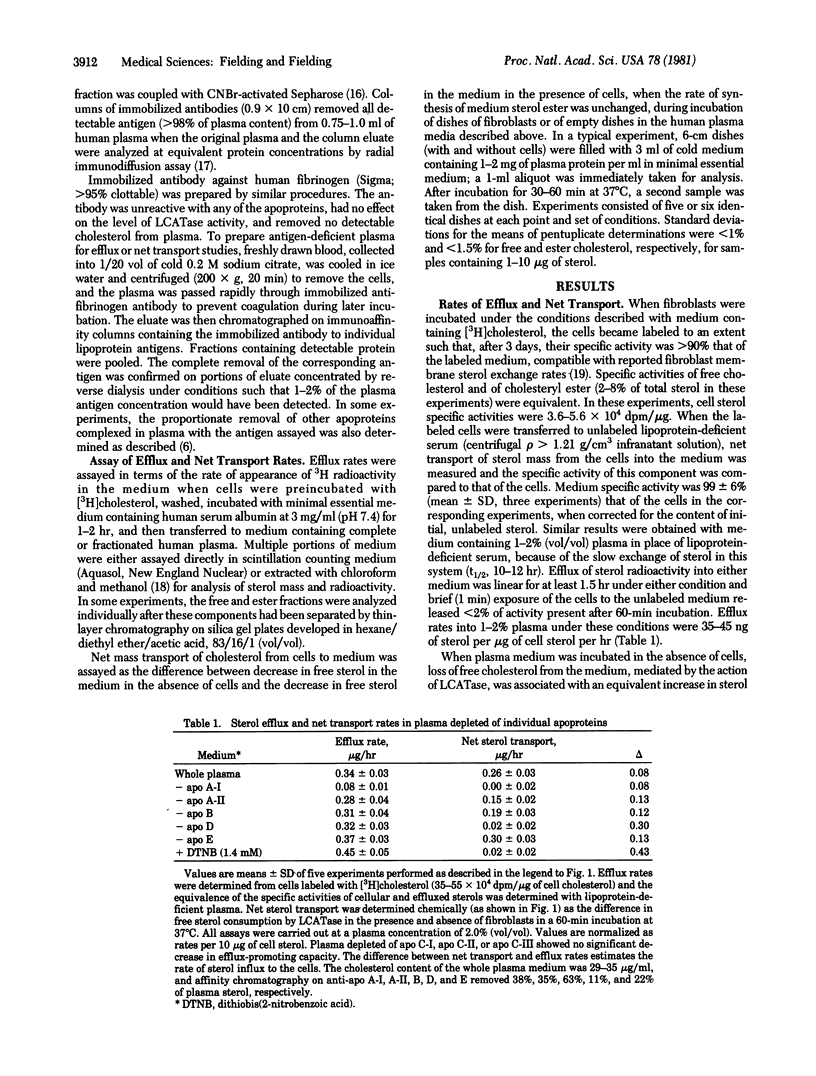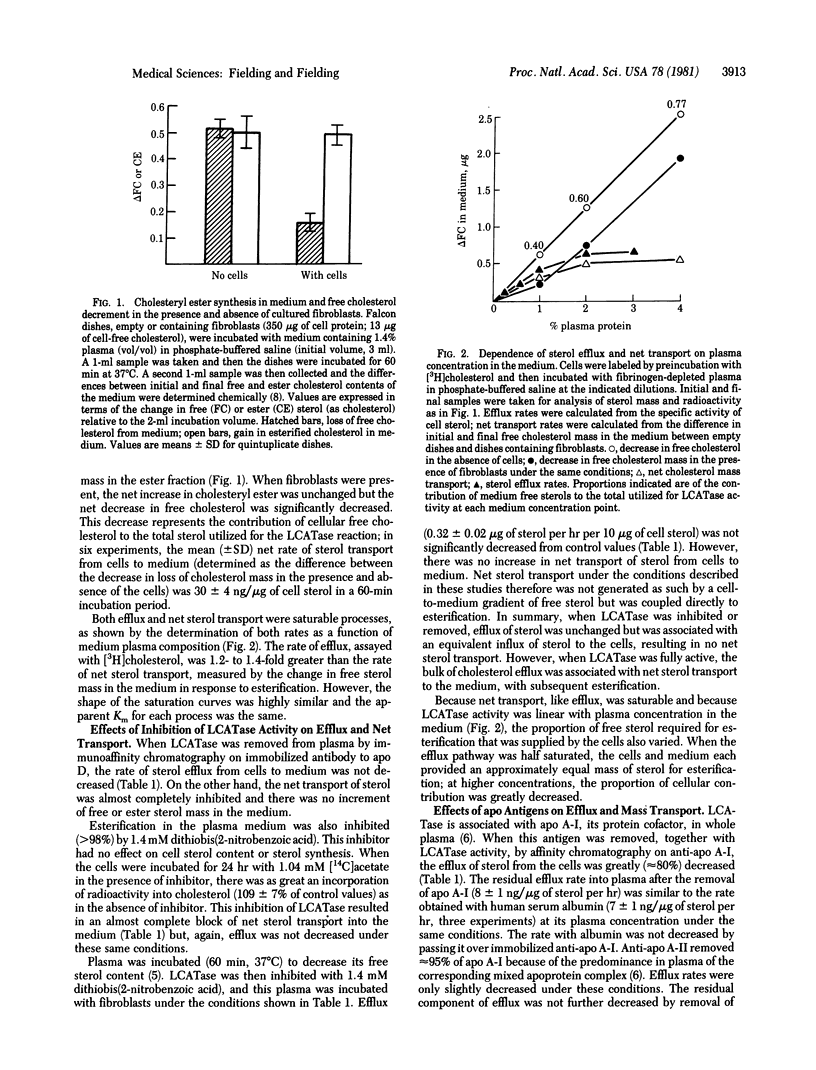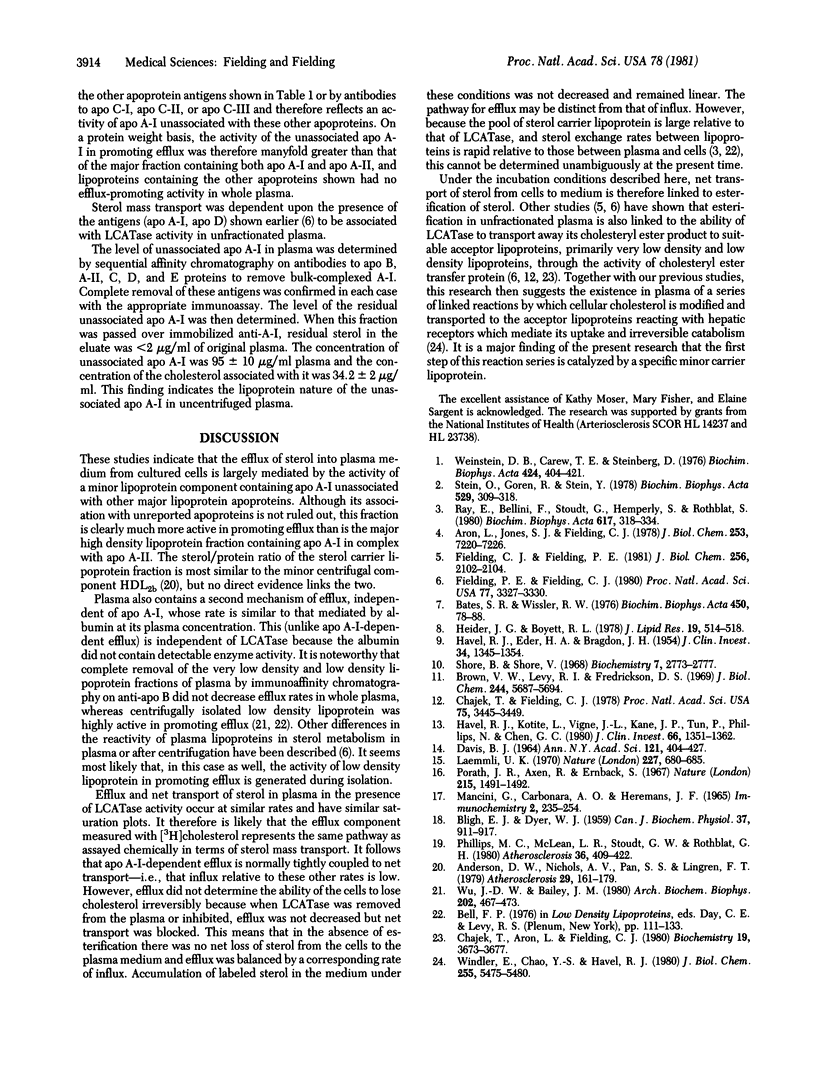Abstract
Immunoaffinity chromatography has been used to study the determinants of sterol efflux and net transport from cultured fibroblasts to human plasma medium. Sterol efflux was highly (approximately 80%) dependent upon a minor lipoprotein fraction containing apolipoprotein A-I unassociated with other apolipoproteins. The remaining activity was associated with the lipoprotein-free fraction of plasma and could be replaced by apoprotein-free albumin. Efflux was independent of lecithin:cholesterol acyltransferase (EC 2.3.1.43) activity. Net transport (i.e., the excess of efflux over influx) was completely inhibited by inhibition of lecithin:cholesterol acyltransferase or its removal by affinity chromatography on immobilized antibodies to apolipoprotein A-I or D (components of the transfer complex in human plasma). In uninhibited plasma, efflux and net transport rates had similar kinetics, suggesting that these were linked functions and that net transport was initiated by a carrier-dependent efflux step that, in the absence of lecithin:cholesterol acyltransferase activity, was associated with an equivalent influx of free sterol to the cells and that, in the presence of lecithin:cholesterol acyltransferase, was associated with esterification and transfer protein activity. The cholesterol carrier lipoprotein function (approximately 5% of plasma apolipoprotein A-I) appears to be the first step of lecithin:cholesterol acyltransferase-linked sterol transport from cells.
Full text
PDF



Selected References
These references are in PubMed. This may not be the complete list of references from this article.
- Anderson D. W., Nichols A. V., Pan S. S., Lindgren F. T. High density lipoprotein distribution. Resolution and determination of three major components in a normal population sample. Atherosclerosis. 1978 Feb;29(2):161–179. doi: 10.1016/0021-9150(78)90005-9. [DOI] [PubMed] [Google Scholar]
- Aron L., Jones S., Fielding C. J. Human plasma lecithin-cholesterol acyltransferase. Characterization of cofactor-dependent phospholipase activity. J Biol Chem. 1978 Oct 25;253(20):7220–7226. [PubMed] [Google Scholar]
- BLIGH E. G., DYER W. J. A rapid method of total lipid extraction and purification. Can J Biochem Physiol. 1959 Aug;37(8):911–917. doi: 10.1139/o59-099. [DOI] [PubMed] [Google Scholar]
- Bates S. R., Wissler R. W. Effect of hyperlipemic serum on cholesterol accumulation in monkey aortic medial cells. Biochim Biophys Acta. 1976 Oct 21;450(1):78–88. doi: 10.1016/0005-2760(76)90300-3. [DOI] [PubMed] [Google Scholar]
- Brown W. V., Levy R. I., Fredrickson D. S. Studies of the proteins in human plasma very low density lipoproteins. J Biol Chem. 1969 Oct 25;244(20):5687–5694. [PubMed] [Google Scholar]
- Chajek T., Aron L., Fielding C. J. Interaction of lecithin:cholesterol acyltransferase and cholesteryl ester transfer protein in the transport of cholesteryl ester into sphingomyelin liposomes. Biochemistry. 1980 Aug 5;19(16):3673–3677. doi: 10.1021/bi00557a006. [DOI] [PubMed] [Google Scholar]
- Chajek T., Fielding C. J. Isolation and characterization of a human serum cholesteryl ester transfer protein. Proc Natl Acad Sci U S A. 1978 Jul;75(7):3445–3449. doi: 10.1073/pnas.75.7.3445. [DOI] [PMC free article] [PubMed] [Google Scholar]
- DAVIS B. J. DISC ELECTROPHORESIS. II. METHOD AND APPLICATION TO HUMAN SERUM PROTEINS. Ann N Y Acad Sci. 1964 Dec 28;121:404–427. doi: 10.1111/j.1749-6632.1964.tb14213.x. [DOI] [PubMed] [Google Scholar]
- Fielding C. J., Fielding P. E. Regulation of human plasma lecithin:cholesterol acyltransferase activity by lipoprotein acceptor cholesteryl ester content. J Biol Chem. 1981 Mar 10;256(5):2102–2104. [PubMed] [Google Scholar]
- Fielding P. E., Fielding C. J. A cholesteryl ester transfer complex in human plasma. Proc Natl Acad Sci U S A. 1980 Jun;77(6):3327–3330. doi: 10.1073/pnas.77.6.3327. [DOI] [PMC free article] [PubMed] [Google Scholar]
- HAVEL R. J., EDER H. A., BRAGDON J. H. The distribution and chemical composition of ultracentrifugally separated lipoproteins in human serum. J Clin Invest. 1955 Sep;34(9):1345–1353. doi: 10.1172/JCI103182. [DOI] [PMC free article] [PubMed] [Google Scholar]
- Havel R. J., Kotite L., Vigne J. L., Kane J. P., Tun P., Phillips N., Chen G. C. Radioimmunoassay of human arginine-rich apolipoprotein, apoprotein E. Concentration in blood plasma and lipoproteins as affected by apoprotein E-3 deficiency. J Clin Invest. 1980 Dec;66(6):1351–1362. doi: 10.1172/JCI109988. [DOI] [PMC free article] [PubMed] [Google Scholar]
- Heider J. G., Boyett R. L. The picomole determination of free and total cholesterol in cells in culture. J Lipid Res. 1978 May;19(4):514–518. [PubMed] [Google Scholar]
- Laemmli U. K. Cleavage of structural proteins during the assembly of the head of bacteriophage T4. Nature. 1970 Aug 15;227(5259):680–685. doi: 10.1038/227680a0. [DOI] [PubMed] [Google Scholar]
- Mancini G., Carbonara A. O., Heremans J. F. Immunochemical quantitation of antigens by single radial immunodiffusion. Immunochemistry. 1965 Sep;2(3):235–254. doi: 10.1016/0019-2791(65)90004-2. [DOI] [PubMed] [Google Scholar]
- Porath J., Axen R., Ernback S. Chemical coupling of proteins to agarose. Nature. 1967 Sep 30;215(5109):1491–1492. doi: 10.1038/2151491a0. [DOI] [PubMed] [Google Scholar]
- Ray E., Bellini F., Stoudt G., Hemperly S., Rothblat G. Influence of lecithin:cholesterol acyltransferase on cholesterol metabolism in hepatoma cells and hepatocytes. Biochim Biophys Acta. 1980 Feb 22;617(2):318–334. doi: 10.1016/0005-2760(80)90174-5. [DOI] [PubMed] [Google Scholar]
- Shore B., Shore V. Heterogeneity in protein subunits of human serum high-density lipoproteins. Biochemistry. 1968 Aug;7(8):2773–2777. doi: 10.1021/bi00848a011. [DOI] [PubMed] [Google Scholar]
- Stein O., Goren R., Stein Y. Removal of cholesterol from fibroblasts and smooth muscle cells in culture in the presence and absence of cholesterol esterification in the medium. Biochim Biophys Acta. 1978 May 25;529(2):309–318. doi: 10.1016/0005-2760(78)90074-7. [DOI] [PubMed] [Google Scholar]
- Weinstein D. B., Carew T. E., Steinberg D. Uptake and degradation of low density lipoprotein by swine arterial smoot muscle cells with inhibition of cholesterol biosynthesis. Biochim Biophys Acta. 1976 Mar 26;424(3):404–421. doi: 10.1016/0005-2760(76)90030-8. [DOI] [PubMed] [Google Scholar]
- Windler E., Chao Y., Havel R. J. Determinants of hepatic uptake of triglyceride-rich lipoproteins and their remnants in the rat. J Biol Chem. 1980 Jun 10;255(11):5475–5480. [PubMed] [Google Scholar]
- Wu J. D., Bailey J. M. Lipid metabolism in cultured cells: studies on lipoprotein-catalyzed reverse cholesterol transport in normal and homozygous familial hypercholesterolemic skin fibroblasts. Arch Biochem Biophys. 1980 Jul;202(2):467–473. doi: 10.1016/0003-9861(80)90451-8. [DOI] [PubMed] [Google Scholar]


